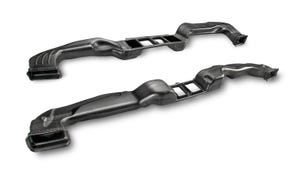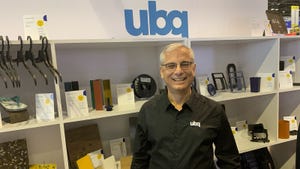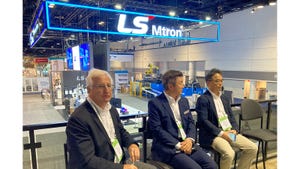WEB EXCLUSIVE : Resin dryer technologies for today?s marketplace
March 1, 2002
|
Weigh drying, as shown in the Comet system above, is especially suitable for nylon and PET processors. It lends itself to controlling and recording, via a remote computer, the drying temperatures, dewpoint, residence time of the resin, and resin usage per machine for every shot of hygroscopic material used. |
|
The AEC/Whitlock T Series machine-mount (above), cart-mount (above), and floor-mount dehumidifying dryers provide 10 to 225 cfm capacity. One dryer connected to multiple hoppers for a centralized drying system can dry multiple materials at different temperatures simultaneously. |
To find the right dryer for your processing needs and your plant?s environment, you must first understand the various dryer technologies that are available today. The following discussion from an industry veteran should help.
|
The Novatec NovaDrier, with no desiccant bed, is said to provide a constant source of ?40F or lower dewpoint process air with no spikes or deviations. Standard plant compressed air is passed through a two-stage prefiltering system that includes a 1-µm filter and a .01-µm filter. The air then passes through a self-regenerating drying media. After it is heated, the air is circulated through an insulated drying hopper. Moisture is purged, dust particles are filtered, and the air is reheated and recirculated along with fresh incoming compressed air. |
Material drying is an important influence on the quality of plastic parts and products. Proper drying is fundamental to obtaining the best production yield possible. Drying is the only premolding process that must be performed mechanically. There are many types of auxiliary equipment that reduce or eliminate the need for labor, but drying has little or nothing to do with labor requirements.
Choosing the correct dryer can be difficult in today?s market. There are as many types of dryers as there are drying manufacturers, and all of the equipment has the same goal: dry resin efficiently and economically. So how does a processor in today?s market make sure it gets the best dryer to meet its specific drying needs? As manufacturers and distributors of multiple styles of drying technology, we will attempt to address this question.
Basics of Resin Dryers
The first step in understanding which dryer is correct for your facility is to understand what a resin dryer does. Typically, a dehumidification unit provides hot air to the resin, which allows for moisture to be released from the resin. Then it removes the moisture from the pellets with dry air, created by a drying media. This allows the hot, dry air to be reused in a closed loop and to continue to remove and release the moisture. It also recycles hot air to save energy. This is how single-bed, multiple-bed, rotary canister desiccant, rotary honeycomb bed, and some compressed air dryers function.
Normally, the distinguishing characteristics for these units are how they heat the air, how they use this hot air, how they remove the moisture from the air, and how they regenerate the drying media. The typical twin tower design of desiccant dryers as well as smaller twin bed and even rotary cartridge desiccant dryers are some of the oldest of the drying technologies sold today.
Desiccant dryers typically use large electric heaters and oversized blowers to obtain the temperature and humidity-free air that is required to dry plastics. These dryers have large beds of desiccant that create substantial airflow resistance to drying air, which is why they require oversized blowers. The scale of these units requires large heaters to maintain a constant temperature. These units function well and typically last a very long time. Desiccant dryers, however, tend to consume a lot of energy. When this technology was invented more than 50 years ago, energy was affordable and consumption wasn?t a major concern for processors.
Unfortunately, today?s ultramodern facilities demand a better use of energy to maintain quality and lower the bottom line. This is why drying systems that use honeycomb rotary bed, compressed air, vacuum, and natural gas technologies have been introduced to the market. These units offer alternative drying methods, and each is designed to use energy more efficiently.
So Many Different Dryers
|
Two new models of the Universal Dynamics PCT2 dehumidifying dryer have drying capacity of 2000 to 2500 cfm. The PCT2 dryer uses Pulse Cooling Technology and is available in eight different sizes. With the FN microprocessor control, the Material Saver function, and a return air cooling coil, the PCT2 uses a cabinet enclosure with a minimal footprint. The dryer has a drying temperature range of 150 to 375F. |
Natural gas dryers are similar in function to the twin tower desiccant units. However, they offer a heating source that is an alternative to electric heaters. In places where natural gas is less expensive than electricity, drying with natural gas could be a good alternative. Unfortunately, increases in natural gas prices in North America over the past year have left some processors looking for lower energy consumption rather than alternative energy sources. It has become apparent, especially in North America, that cheap energy is a thing of the past. This has forced processors to find equipment that consumes small amounts of energy in order to save money, especially in areas such as Mexico, where processors have reported energy costs up to three times higher than in the U.S.
|
A stainless steel twin desiccant bed design, with a high-capacity molecular sieve, provides an operating dewpoint of -40F for closed loop drying in the Drymax compact desiccant dryer from Nucon Wittmann. Individual, electrically operated switch-over valves for each desiccant bed reportedly avoid heat transfer between the drying and regeneration cycle to improve process efficiency. Drymax dryers incorporate microprocessor control. |
Compressed air dryers recycle dry air and eliminate the need for drying media. These dryers use a loop of hot air and compressed air?which is typically lower in moisture than ambient air?to dry resin. These units have few replacement parts, and much of the air does not require a media to remove moisture.
The downside of these dryers is that compressed air can be very expensive to generate. Typically, air compressors use tremendous amounts of energy to generate the quantity of air needed. Therefore, the energy saved in using such a unit is spent at the compressor. The design of these units assumes that the compressed air being used is dry and clean, which requires regular compressor maintenance and constant monitoring of compressed air lines.
There are newer dryers being produced that use compressed air and a proprietary media that removes moisture and contamination from the air and resin. These include electric heaters, but require large amounts of compressed air.
Vacuum drying has recently been improved and reintroduced into injection molding. These units operate by heating small batches of material. Once these batches rise to a designated temperature, a vacuum is initiated, which allows the surface moisture to be boiled off. This works because water boils at lower temperatures in a partial vacuum than at normal atmospheric pressure. The material then moves from the vacuum to a separate area, pending loading into the injection machine. Because the material is not heated continuously and not allowed to maintain this heat, reintroduction of moisture is a potential issue when drying hygroscopic resins.
There are several unique advantages to this equipment vs. other dryers. First, there are no drying media that require regeneration, which offers good energy savings. Also, since it is a batch system, a full hopper of material is not dried, making vacuum systems ideal for small part runs. The units are well suited for the predrying of nonhygroscopic resins and are known to increase production yields dramatically for these types of resins.
Hot air dryers can be a solution in areas that remain at relatively low humidity levels throughout the year. A hot air dryer with a 65-lb hopper costs around $775 with insulation. Given the correct conditions, this is an economical solution for processors.
|
The Low Pressure Dryer (LPD) from Maguire uses a vacuum to dry resin, with reported potential savings of $14,000 per year per processing line, as compared with a conventional desiccant dryer. In tests of two 100-lb/hr (45 kg/hr) units installed on side-by-side injection molding machines, the LPD dryer underwent Monday-morning cold startups and midrun color changes with minimal downtime, and required substantially less energy to properly dry resin. |
Typically, these units, which only supply hot air and have no dehumidification system, are used on nonhygroscopic materials as a preheater. Similar to vacuum dryers, these units allow for much higher yields of materials that are not traditionally dried by removing surface moisture. In areas of North America that have relatively low humidity, a processor can use these units on hygroscopic materials with positive results. Also, with hardware consisting of only one blower and a heater, maintenance and service costs are minimal. For molders not fortunate enough to live in such dry areas of the world, dehumidification of the resin is a necessity.
|
|
Honeycomb rotary bed drying units are now available at an affordable price, thanks to recent advances in silica, molecular sieve, and other drying mediums. A honeycomb dryer with 50 cfm of unrestricted air now costs around $5400, with the suggested return-air cooler. Even at decreased prices, the technology is sometimes not chosen because molders are not familiar with it. Honeycomb rotary-bed drying units are similar to other forms of drying technology, except for the dehumidifying media used to remove moisture from the air. These dryers use crystallized molecular sieves and silica gels that are baked onto the drying wheel to yield dehumidified air and material. The silica gel does not create dust like a desiccant unit, which can contaminate parts. It also absorbs and releases moisture much more efficiently than any other type of dryer. The honeycomb wheel allows air to pass easily over the drying media, and because it releases moisture better than desiccant beads, only a small blower and electric heater are required, saving considerable energy.
Honeycomb dryers operate in constant process drying so that the dewpoint of the drying air is constant. Thanks to these modern silica and sieves, a lower dewpoint also can be achieved than with desiccant. The advanced honeycomb media can be washed with soapy water if it becomes dirty and can last up to 10 years vs. the two-year life of desiccant. This means that maintenance and service costs are greatly reduced. The energy savings pay off on the bottom line, and the modern silica allows for better yields in a modern facility.
Weigh-Drying Technology
Energy savings and total cost savings are very important in the purchase of any new equipment. Some recent technology in drying has come not as a result of new dryer designs, but in the systems built around these designs. One design gaining popularity with nylon and polyethylene terephthalate (PET) molders is that of weigh drying, a technology that weighs all material being dried and calculates drying settings. These patented systems also perform complex functions such as recording and controlling the drying temperature, dewpoint, residence time of the resin, and resin usage per machine for every shot of material in the facility. What this means is that a processor can guarantee to its customers that the product it is purchasing has been dried appropriately.
The weigh dryer is a good match for captive molders using high volumes of hygroscopic materials, such as nylon and PET, or heat sensitive materials. However, the system does require high-quality controls.
In the case of nylon and some other polymers, mishandling or overdrying is known to result in everything from discoloration to product failure. Weigh-drying systems give molders the ability to prove their handling conditions for every part and eliminate costly part returns and reruns of parts. A weigh system can generally be retrofitted onto an existing drying system or purchased complete. By retrofitting these systems, modern processors save money, use the equipment they already have, and are able to achieve consistent, high-quality production yields.
Editor?s note: Tom Rajkovich is president and Sam Rajkovich is dryer manager for Comet Automation Systems Inc.
Comet Automation Systems
Dayton, OH
Tom Rajkovich
(937) 296-9166
www.cometauxiliary.com
The design and operation of a carousel dryer |
Contact information
Conair
Ben Martin
Pittsburgh, PA
(412) 312-6000
www.conairnet.com
Maguire Products
Terry Good
Aston, PA
(610) 459-2412
www.maguire.com
AEC Whitlock
Joe Sweeney
Wood Dale, IL
(630) 595-1060
www.aecinternet.com
Dri-Air Industries
Herb Wischow
East Windsor, CT
(860) 627-5110
www.dri-air.com
Novatec
James Smith
Baltimore, MD
(410) 789-4811
www.novatec.com
Universal Dynamics
John Fleischer
Woodbridge, VA
(703) 491-2191
www. autoload-inc.com
Nucon Wittmann
Rob Miller
Markham, ON
(888) 466-8266
www.nuconsystems.com
You May Also Like










